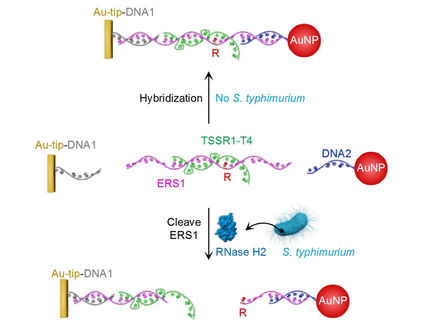Glow Reveals Dangerous Bacteria
Chemiluminescence probes for the rapid and sensitive detection of salmonella and listeria
Salmonella and listeria are among the most widely distributed and deadliest causes of foodborne infections. Their rapid and reliable detection on food and industrial food processing equipment is very important. In the journal Angewandte Chemie, scientists have introduced a new, ultrasensitive, chemiluminescence-based method for the direct detection of Salmonella and Listeria monocytogenes. Because of the simplicity and sensitivity, this test is significantly faster than conventional methods and can be carried out in the field.

© Wiley-VCH
It is estimated that about a million people per year are infected with salmonella infections in the USA alone. Of these, 380 die. Infections with listeria can also often be fatal. Current testing methods usually require the growth of bacterial cultures in a containment laboratory. A conclusive result based on standard diagnostic techniques generally takes two to six days.
Researchers working with Urs Spitz and Doron Shabat at the University of Tel Aviv, Nemis Technologies AG (Zurich, Switzerland), Zurich University of Applied Sciences, and Biosynth AG (Staad, Switzerland) have now introduced a new and efficient method for the ultrasensitive and significantly faster detection of Salmonella and Listeria. The method is based on chemiluminescence—the emission of light resulting from a chemical process. The simplicity of the tests allows for both enrichment of the bacteria and their detection in a test tube, with no further sample preparation, so no containment laboratory is required. The chemiluminescence probes have proven to be about 600 times more sensitive than conventional fluorescence probes.
The success of this technique is due to two specially developed probe molecules made by combining a luminescent substance (a phenoxy-dioxetane) with a “trigger”. In this form the probe does not light up. The trigger is tailored to the bacteria to be detected: it is recognized by a specific enzyme produced by the pathogen—a special esterase in the case of Salmonella and a special phospholipase C for Listeria—that splits it from the luminescent part. This initiates a chemical reaction that causes the luminescent molecule to split off more pieces. The energy released by the reaction is emitted in the form of a very intense green glow. Tests with various bacteria demonstrated that the probe tailored to Listeria test only reacts to Listeria monocytogenes, not to other, non-pathogenic, strains of listeria. The intensity of the glow can be used to quantify the concentration of bacteria. The tests are so sensitive that, for example, a count of ten salmonella can be detected within six hours of enrichment. Even dried bacteria can be swabbed from surfaces and detected.
The researchers are confident that their new method can be used more broadly to develop specific chemiluminescence probes for other bacteria.
Original publication
Other news from the department science

Get the analytics and lab tech industry in your inbox
By submitting this form you agree that LUMITOS AG will send you the newsletter(s) selected above by email. Your data will not be passed on to third parties. Your data will be stored and processed in accordance with our data protection regulations. LUMITOS may contact you by email for the purpose of advertising or market and opinion surveys. You can revoke your consent at any time without giving reasons to LUMITOS AG, Ernst-Augustin-Str. 2, 12489 Berlin, Germany or by e-mail at revoke@lumitos.com with effect for the future. In addition, each email contains a link to unsubscribe from the corresponding newsletter.

























































